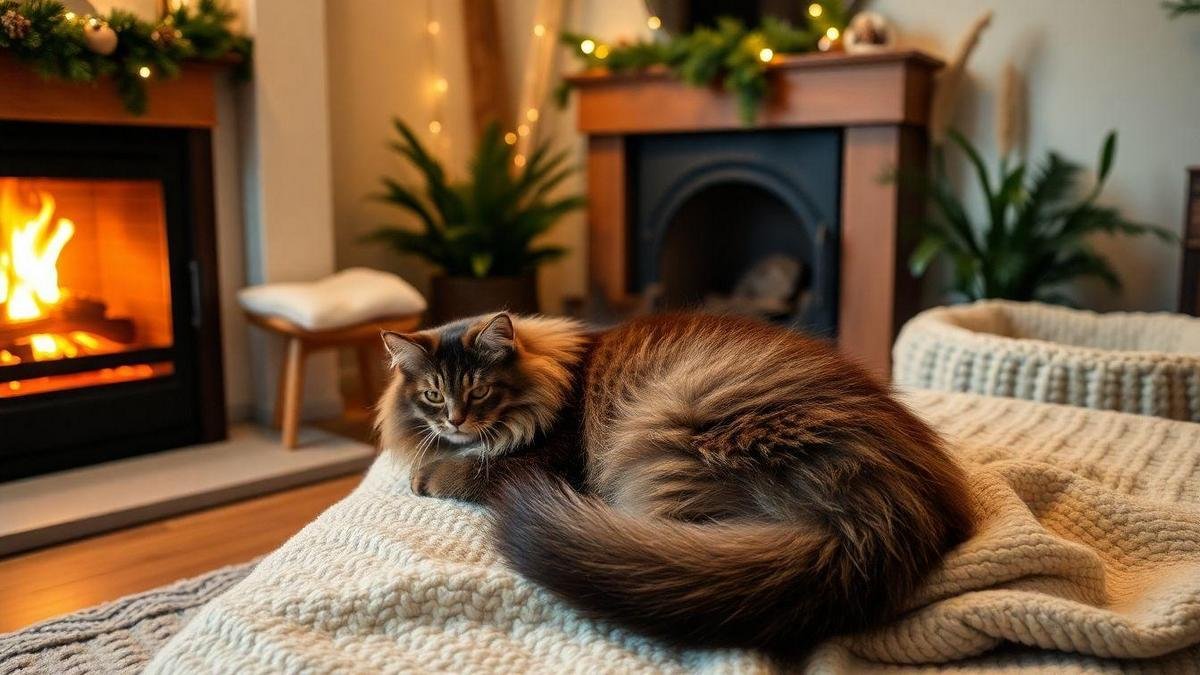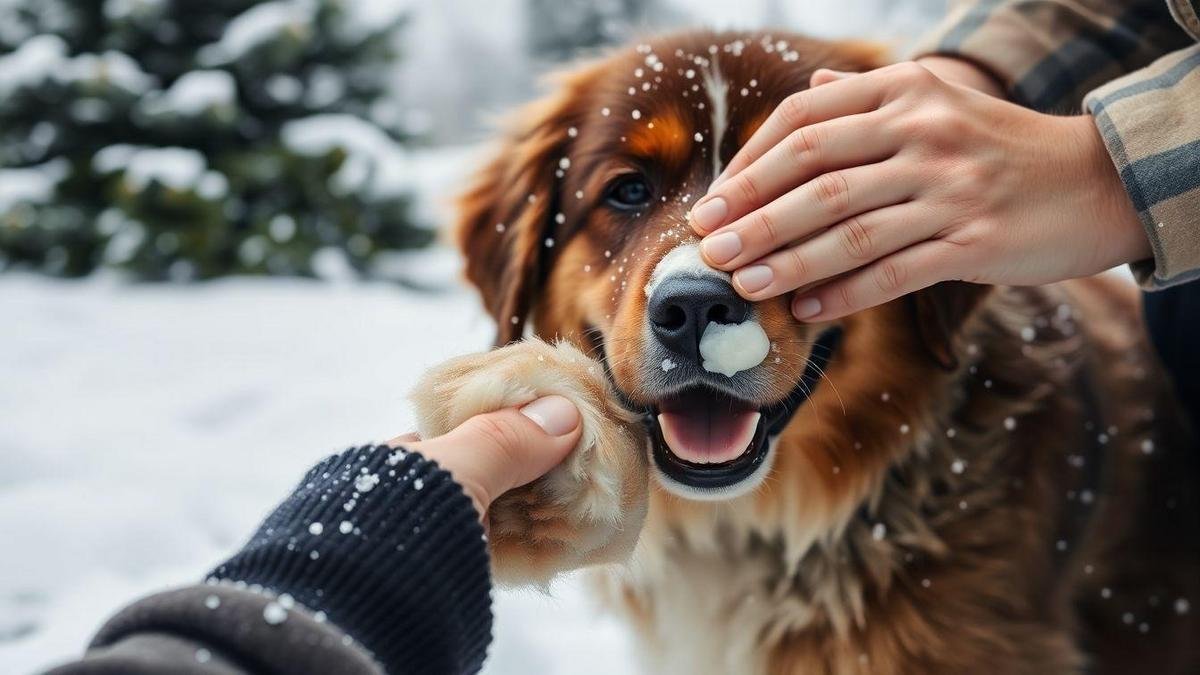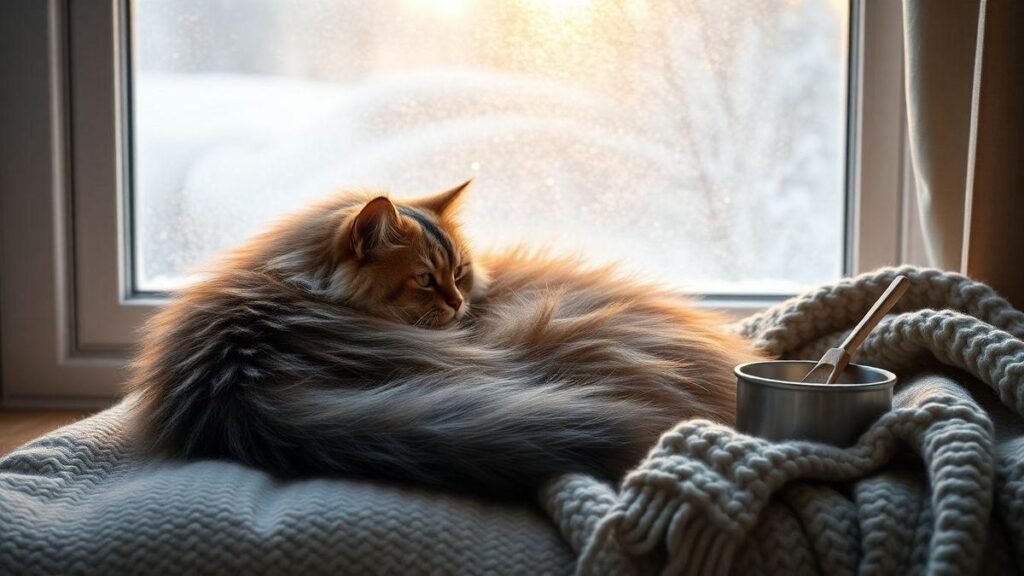Dicas de cuidados para gatos com pelagem longa durante o inverno, I write this to share the simple, caring steps I use to keep my longhaired cat warm and safe indoors. I place soft beds and blankets in sunny spots and close windows to stop cold drafts. I brush daily with a wide-tooth comb and slicker brush to cut shedding and prevent mats, and I keep grooming calm and short. I separate knots with my fingers and call a groomer for big tangles. I wipe paws, trim fur between toes, and use vet-approved balm only if pads look sore. I offer wet food, extra water, and run a humidifier for healthy skin. I keep heaters out of reach, cover cords, and watch weight and energy so I can call my vet if anything worries me.
Key Takeaway
- I brush my cat daily to stop tangles and mats
- I keep fresh water near my cat so they stay hydrated
- I give my cat a warm, draft-free bed
- I check my cat’s paws for ice and salt after outdoor time
- I watch my cat’s weight and energy and call the vet if I worry

How I keep my longhaired cat warm indoors
I place soft beds and blankets in warm spots to help with keeping longhaired cats warm indoors
When the cold weather hits, I create cozy spots for my longhaired cat. I scatter soft beds and plush blankets around the house, especially in sunny areas. Cats love to soak up warmth, and a sunbeam can feel like a warm hug. I often find my furry friend curled up in her favorite blanket, looking like a fluffy burrito. It warms my heart to see her comfortable and happy.
I limit cold drafts and close windows to protect my cat from chill
I pay close attention to where the drafts come from in my home. Cold air sneaks in through cracks and open windows, and I don’t want my cat to feel that chill. I make it a habit to close windows and seal any gaps I find. It’s like putting on a warm coat for my kitty. I want her to feel snug and safe from the winter winds.
I check room temperature and move bedding if a spot feels cold
To keep my cat cozy, I often check the room temperature. If I feel a draft or a chill, I quickly move her bedding to a warmer spot. It’s like creating a little haven just for her. I want her to have a snug place to nap, away from the cold. After all, her comfort is my priority, and I love knowing I’m taking care of her needs.

My longhaired cat grooming routine for winter
I brush daily to reduce winter shedding and follow longhaired cat grooming in winter tips
When winter rolls around, I notice that my longhaired cat tends to shed more than usual. To tackle this, I make it a point to brush daily. This simple act not only helps keep my home fur-free but also allows me to bond with my furry friend. I’ve learned a few grooming tips that really help.
I use a wide-tooth comb and slicker brush to gently remove loose hair
In my grooming kit, I have a wide-tooth comb and a slicker brush. The wide-tooth comb is perfect for untangling any knots without pulling on my cat’s delicate fur. The slicker brush comes in handy for removing loose hair. Together, they work wonders to keep my cat’s coat looking shiny and healthy.
| Tool | Purpose |
|---|---|
| Wide-tooth comb | Untangles knots |
| Slicker brush | Removes loose hair |
I make grooming calm and short to keep my cat relaxed
I’ve noticed that keeping grooming sessions calm and short makes a big difference. I try to spend about 10-15 minutes each day. This way, my cat doesn’t feel overwhelmed. I talk softly, give gentle pets, and sometimes even offer a treat. It’s all about creating a cozy atmosphere, making grooming a pleasant experience for both of us.

How I prevent mats and treat tangles safely
I trim and comb problem areas to focus on preventing mats in longhaired cats
Taking care of my longhaired cat is like navigating a delicate dance. I’ve learned that prevention is key when it comes to mats. I make it a point to regularly trim and comb areas that tend to get tangled. This way, I can keep those pesky mats at bay. I often spend a few minutes each day focusing on the areas behind the ears and under the legs, where mats love to sneak in.
I separate small knots with my fingers before using a comb to avoid pulling
When I find a small knot, I don’t rush in with a comb right away. Instead, I gently separate the strands with my fingers. This approach helps me avoid pulling on my cat’s fur, which can be uncomfortable for her. I take my time, working through the tangles carefully. It’s all about being gentle and patient, and I can see my cat appreciates it too.
I use detangling tools and seek a groomer for big mats
For those stubborn mats that just won’t budge, I turn to my trusty detangling tools. They make a world of difference, allowing me to tackle bigger knots without causing pain. However, if I encounter a mat that seems too tough for me, I don’t hesitate to seek help from a professional groomer. Sometimes, it’s best to call in the experts, especially when my cat’s comfort is at stake.
| Method | Description |
|---|---|
| Trim and Comb | Focus on problem areas regularly to prevent mats. |
| Finger Separation | Gently separate knots with fingers before combing. |
| Detangling Tools | Use specialized tools for stubborn mats. |
| Professional Groomer | Seek help for large mats that are difficult to manage. |

My paw care routine for cold weather
I wipe my cat’s paws after coming inside to avoid icy salt and chemicals and for longhaired cat paw care in winter
When winter rolls in, I make it a point to wipe my cat’s paws every time she comes inside. The icy salt and chemicals on the sidewalks can be harsh on her delicate paws. I keep a soft cloth near the door just for this. It’s a simple step, but it makes a world of difference.
For my longhaired cat, this routine is even more important. The snow can cling to her fur, creating little ice balls between her toes. By wiping her paws, I help keep her comfortable and safe from any harmful substances she might pick up outside.
I check paw pads for cracks and keep fur trimmed between toes to stop ice build-up
I always take a moment to check her paw pads for any cracks. The cold weather can be tough on them, and I want to catch any issues early. If I see any cracks, I know I need to be extra careful in the coming days.
Also, I make sure to trim the fur between her toes regularly. This helps stop ice from building up and keeps her paws clean. It’s like giving her a little winter spa treatment!
I apply vet-approved balm only if pads look sore or dry
If I notice her paw pads looking sore or dry, I reach for a vet-approved balm. I only use it when necessary, as I don’t want to overdo it. A little goes a long way, and it can really help soothe her paws.

How I keep my cat hydrated and protect skin in winter
I offer wet food and extra fresh water to help with hydration and skin care for cats in winter
When winter comes knocking, I know my cat needs a little extra care. Hydration becomes super important during these cold months. I make sure to give my cat wet food because it helps keep her hydrated. It’s like giving her a drink with every meal! I also keep fresh water available at all times. I change it daily to keep it clean and appealing. Sometimes, I even add a splash of low-sodium chicken broth to entice her, following hydration tips for pets.
I run a humidifier in dry rooms to reduce flaky skin and hair breakage
The air can get pretty dry in winter, which can lead to flaky skin for my furry friend. To combat this, I run a humidifier in the rooms where we spend the most time. It adds moisture to the air, making it more comfortable for both of us. I’ve noticed that since I started using it, my cat’s coat looks shinier and healthier. It’s like giving her a spa day right at home!
I watch for excessive scratching and call my vet if skin looks damaged
I keep a close eye on my cat’s behavior. If I notice her scratching too much, I take it seriously. Excessive scratching can mean her skin is irritated or dry. If I see any signs of damage, like redness or bald spots, I don’t hesitate to call my vet. It’s always better to be safe and get the right advice. I want my cat to feel comfortable and happy, especially during the chilly months.

My safety and nutrition steps for cold months
I follow indoor heating safety for cats by keeping heaters out of reach and covering cords
When the cold months roll in, I make sure my home is a safe haven for my furry friend. Heaters can be tempting for curious cats, so I always keep them out of reach. I also cover any exposed cords to prevent those playful paws from getting tangled or burned. It’s a simple step, but it really gives me peace of mind knowing my cat is safe while staying warm.
I adjust feeding only after talking to my vet about cold weather nutrition for longhaired cats
As the temperature drops, I think about how to keep my longhaired cat healthy. Before I change her diet, I always have a chat with my vet. They help me understand what kind of nutrition she needs during the winter months. For instance, some cats may need more calories to stay warm, while others might not. It’s all about what’s best for her!
I monitor weight and energy so I can change food or heating safely with vet advice
I keep a close eye on my cat’s weight and energy levels. If I notice she’s gaining weight or seems less playful, I know it’s time to reassess her food or heating situation. With my vet’s guidance, I can make the right adjustments. This way, I know I’m doing everything I can to keep her happy and healthy during the chilly season.
Conclusion
In conclusion, caring for my longhaired cat during the winter months is not just a task; it’s a labor of love. I’ve learned that simple steps can make a world of difference in keeping her warm, comfortable, and healthy. From creating cozy spots with soft beds and blankets to daily grooming, every action I take is a way to show her how much I care.
I pay attention to her hydration, watch for any signs of discomfort, and ensure her paw care is top-notch. It’s like wrapping her in a warm hug, protecting her from the harsh winter elements. I also stay in tune with her nutritional needs, adjusting her diet with the guidance of my vet to keep her energetic and happy.
Ultimately, my goal is to create a safe haven where my furry friend can thrive. I invite you to explore more articles at Blog Craelo for additional tips and insights on keeping your beloved pets healthy and happy!
Frequently asked questions
–
How do I keep my longhaired cat warm in winter?
I give my cat a soft bed and extra blankets. I keep rooms warm and check for shivering. I like heated pads made for pets.
–
How often should I groom my longhaired cat during cold months?
I brush my cat every day or every other day. I stop mats before they form. It feels good for both of us.
–
Can I trim my cat’s fur to help in winter?
I avoid full shaving. I trim only messy mats. I ask my vet or groomer when I’m unsure.
–
Should I change my cat’s food or water in winter?
I give slightly more calories if my cat goes outside. I always keep fresh water available. I watch my cat’s weight and energy.
–
How do I protect my cat’s paws and skin from winter dangers, like ice and salts?
I wipe my cat’s paws after a walk. I check for cracks or salt. I follow Dicas de cuidados para gatos com pelagem longa durante o inverno and keep care simple and steady.






